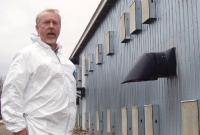
On-farm Feedmill Biosecurity: Employing biosecurity measures for your mill is worthwhile investment
By Dan Woolley
Features Manure Management ProductionEmploying biosecurity measures for your mill worthwhile
For anyone considering an on-farm feedmill, biosecurity should be a major priority, according to Alex Oderkirk.
 |
| BIG RETURNS Alex Oderkirk (above) says there are big returns on doing things right when it comes to biosecurity. He says the biggest risk comes down the laneway via traffic. |
 |
For anyone considering an on-farm feedmill, biosecurity should be a major priority, according to Alex Oderkirk.
A poultry specialist with the agricultural consulting firm, Agra Point, Oderkirk told the Atlantic Poultry Research Institute’s feedmill workshop that biosecurity issues account for 80 per cent of the content of on-farm food safety plan such as HACCP.
He commented: “It is about life security. It’s about your clients and who you are selling to; that what you are selling them is safe.”
Spending on biosecurity in the farm’s feedmill should be considered as an investment, not a cost, insisted Oderkirk, observing, “there are big returns in doing it right.”
Recently, because of product contamination during processing, U.S. packers have had to contend with a recall of 60 million pounds of beef, he said. “Someone is going to be put out of business.”
Oderkirk also defined feedmill biosecurity as being, “about you having total control in your facility.”
As for risks and hazards the feedmill operator must guard against, he said they can be physical such as inorganic heavy metals, or organic threats such as rodents. They can also be chemical as pesticides, herbicides, medications, mycotoxins, petroleum products and disinfectants.
Or, they can be biological as bacteria, viruses, prions, moulds and fungi that are carried into the facility by flies, larvae or animals.
Oderkirk listed eight basic biosecurity measures, including: isolation, controlled access, restricted movement, facility sanitation/housekeeping, equipment maintenance, pest control, staff training and monitoring/testing.
As for how risk material can arrive in a feedmill, he noted, “most come down your laneway, if not all, on vehicles carrying ingredients, people and equipment that hasn’t been cleaned properly.”
Since air and water can carry pathogens, he also recommended areas around the mill should be kept clean and free of garbage.
| CFIA OVERSIGHT The Canadian Food Inspection Agency (CFIA) will make its presence known to the operator of an on-farm feedmill. Besides its inspection visits, generally every three years, to ensure the on-farmfeed mill is operating in compliance with CFIA regulations, the CFIA continually revises its feed production regulations. As of July 12, 2007, an Enhanced Feed Ban, issued by the CFIA, is in effect. This ban extends the prohibited materials regulation for protein originating from mammals. Specific Risk Material (SRM) in feed byproducts derived from brains and spinal cords must now be removed from feeds manufactured for rabbits, minks, foxes, fish and pets, in addition to ruminants. Rob Murray, CFIA’s Atlantic area feed specialist, told the Atlantic Poultry Research Institute’s feedmill workshop the goal of the enhanced ban is to control SRM to prevent the further spread of BSE through other pathways. Medicated Feed The new regulations will apply to all manufacturers of medicated feed for food animals and their feed products will have to be licensed. The new CVS regulatory system provides an efficient and uniform approach to verifying industry compliance to the regulations. It also supports, he added, CFIA’s objective of moving government and the industry to a more science-based risk management approach, while simplifying the inspection process and clearly defining a common enforcement policy. Murray said there are currently 27 participants, including three in Atlantic Canada, in the CVS pilot project, with a rollout for CVS to all feed manufacturing facilities by this September. The proposed CVS regulations will first be published for a 75-day comment period before they are enacted. He anticipated they will be in place by 2009, barring a federal election which could delay their installation. |
The feedmill proprietor can also provide additional biosecurity by controlling access by putting a gate and signs on the laneway, a designated parking area well away from the feed mill, and requiring visitors to sign in, Oderkirk said.
He also recommended that any vehicle should be inspected before it enters the feedmill to ensure it is clean. Ingredients on the truck should also be checked and they should also arrive on-farm either enclosed or covered. The truck’s manifest should also be examined.
“What did it last haul? It shouldn’t be meat or manure in the morning and feed ingredients in the afternoon,” said Oderkirk.
The farmer should also have a policy of refusing supplies if he doesn’t like the look of ingredients when they arrive or the condition of the truck they are shipped in.
The ingredient unloading area should also be cleaned after ingredients are unloaded. Samples of the supplies should also be taken, said Oderkirk, then labelled as to where the ingredients came from and in which bin they were stored. “If you don’t like the look of a sample; send it out for further testing and analysis for nutrient quality and bacteria,” he said.
The feedmill operator can also further enhance his biosecurity by requiring and providing protective clothing for staff and visitors, hand sanitation stations and locked doors and windows on the facility, he said, commenting, “keep it clean inside and out.”
The facility’s integrity can also be maintained by a secure foundation to keep out rodents and a gravel surface surrounding the mill building.
Oderkirk said feed mill biosecurity risks can also be further controlled by minimizing traffic in the mill to keep out cross-contamination. Visitors should be restricted to an office or bio-secure room and the production flow should be just one direction, from the ingredient receiving and storage area, through the mill room and into the finished feed storage and shipping room.
Risks can also be further reduced by ensuring storage bins are well sealed and a separate medication storage/handling area maintained along with a separate scale room to measure out medications, he said.
“Keep medicated materials on the bottom so they don’t spill on other materials if their bag leaks. Keep bulk hoppers closed so they don’t spread dust and cross-contaminate. Don’t store bags against the wall for rodent control. Don’t leave bags open: seal them.”
Garbage bins should also be kept closed and empty bags of risk material should go immediately into these bins, Oderkirk said. “These are risk materials and you don’t want them to go back into the feedmill.”
The dust collection bin should also be outside of the mill and the mill facility should be maintained so it has no leakage, rust, holes or spillage. He observed: “If you do have a spill every animal in the country knows it.”
Other recommendations he made, were to keep vegetation down next to the facility to remove pest habitat, don’t store empty bags and pallets, or have animals for sale next to the feed facility.
Oderkirk also suggested the feedmill operator should initiate a sanitation program by cleaning the farm’s vehicles before they drive off the farm and cleaning the underside of any vehicles that arrive on the farm. He said this may mean drivers need to utilize different truck routes.
Print this page